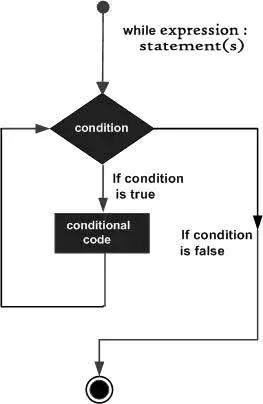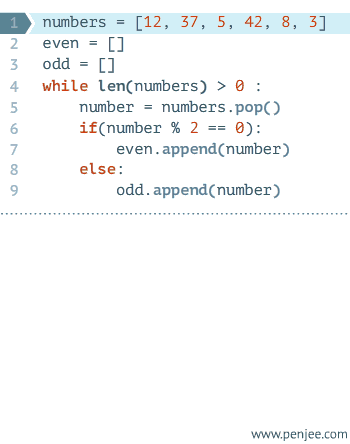Python While循环语句实例演示及原理解析
这篇文章主要介绍了Python While循环语句实例演示及原理解析,文中通过示例代码介绍的非常详细,对大家的学习或者工作具有一定的参考学习价值,需要的朋友可以参考下
Python 编程中 while 语句用于循环执行程序,即在某条件下,循环执行某段程序,以处理需要重复处理的相同任务。其基本形式为:
while 判断条件:
执行语句……
执行语句可以是单个语句或语句块。判断条件可以是任何表达式,任何非零、或非空(null)的值均为true。
当判断条件假false时,循环结束。
执行流程图如下:

Python while 语句执行过程

实例:
#!/usr/bin/python count = 0 while (count < 9): print 'The count is:', count count = count + 1 print "Good bye!"
以上代码执行输出结果:
The count is: 0 The count is: 1 The count is: 2 The count is: 3 The count is: 4 The count is: 5 The count is: 6 The count is: 7 The count is: 8 Good bye!
while 语句时还有另外两个重要的命令 continue,break 来跳过循环,continue 用于跳过该次循环,break 则是用于退出循环,此外"判断条件"还可以是个常值,表示循环必定成立,具体用法如下:
# continue 和 break 用法
i = 1
while i < 10: i += 1 if i%2 > 0: # 非双数时跳过输出
continue
print i # 输出双数2、4、6、8、10
i = 1
while 1: # 循环条件为1必定成立
print i # 输出1~10
i += 1
if i > 10: # 当i大于10时跳出循环
break
无限循环
如果条件判断语句永远为 true,循环将会无限的执行下去,如下实例:
#coding=utf-8
#!/usr/bin/python
var = 1
while var == 1 : # 该条件永远为true,循环将无限执行下去
num = raw_input("Enter a number :")
print "You entered: ", num
print "Good bye!"
以上实例输出结果:
Enter a number :20
You entered: 20
Enter a number :29
You entered: 29
Enter a number :3
You entered: 3
Enter a number between :Traceback (most recent call last):
File "test.py", line 5, in <module>
num = raw_input("Enter a number :")
KeyboardInterrupt
注意:以上的无限循环你可以使用 CTRL+C 来中断循环。
循环使用 else 语句
在 python 中,for … else 表示这样的意思,for 中的语句和普通的没有区别,else 中的语句会在循环正常执行完(即 for 不是通过 break 跳出而中断的)的情况下执行,while … else 也是一样。
#!/usr/bin/python count = 0 while count < 5: print count, " is less than 5" count = count + 1 else: print count, " is not less than 5"
以上实例输出结果为:
0 is less than 5 1 is less than 5 2 is less than 5 3 is less than 5 4 is less than 5 5 is not less than 5
简单语句组
类似if语句的语法,如果你的while循环体中只有一条语句,你可以将该语句与while写在同一行中, 如下所示:
#!/usr/bin/python flag = 1 while (flag): print 'Given flag is really true!' print "Good bye!"
注意:以上的无限循环你可以使用 CTRL+C 来中断循环。
While循环语句实例
猜拳小游戏
#!/usr/bin/python
# -*- coding: UTF-8 -*-
import random
while 1:
s = int(random.randint(1, 3))
if s == 1:
ind = "石头"
elif s == 2:
ind = "剪子"
elif s == 3:
ind = "布"
m = raw_input('输入 石头、剪子、布,输入"end"结束游戏:')
blist = ['石头', "剪子", "布"]
if (m not in blist) and (m != 'end'):
print "输入错误,请重新输入!"
elif (m not in blist) and (m == 'end'):
print "\n游戏退出中..."
break
elif m == ind :
print "电脑出了: " + ind + ",平局!"
elif (m == '石头' and ind =='剪子') or (m == '剪子' and ind =='布') or (m == '布' and ind =='石头'):
print "电脑出了: " + ind +",你赢了!"
elif (m == '石头' and ind =='布') or (m == '剪子' and ind =='石头') or (m == '布' and ind =='剪子'):
print "电脑出了: " + ind +",你输了!"
以上实例输出结果为:
输入 石头、剪子、布,输入"end"结束游戏:石头 电脑出了: 石头,平局! 输入 石头、剪子、布,输入"end"结束游戏:石头 电脑出了: 剪子,你赢了! 输入 石头、剪子、布,输入"end"结束游戏:
以上就是本文的全部内容,希望对大家的学习有所帮助,也希望大家多多支持呐喊教程。
声明:本文内容来源于网络,版权归原作者所有,内容由互联网用户自发贡献自行上传,本网站不拥有所有权,未作人工编辑处理,也不承担相关法律责任。如果您发现有涉嫌版权的内容,欢迎发送邮件至:notice#yiidian.com(发邮件时,请将#更换为@)进行举报,并提供相关证据,一经查实,本站将立刻删除涉嫌侵权内容。

